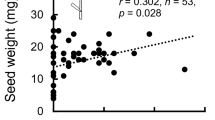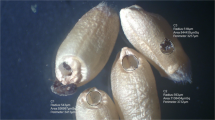Abstract
In this study, we evaluated the damage caused in the field by Tibraca limbativentris Stål adults at different levels of infestation (0, 1, 2, and 4 stink bugs) per three rice plants during three growth stages (V8, V13, and R4 stages) of upland rice cultivated in southwestern of Pará State, Amazon Rainforest region, Brazil. Heading time (panicle exertion) was affected by T. limbativentris infestations mainly in the vegetative stage and the whiteheads percentage in treatments ranged from 18.2 to 38%. The dead hearts percentages varied between 0 and 21.5%, and the mean number of primary branches (ramifications) ranged from 5.9 ± 0.4 to 12.3 ± 0.2. The number of empty spikelets was only affected in infestations with four insects/three plants, while the quantity of filled grains per panicle was affected only when infestations occurred during the vegetative stage. The total number of spikelets (filled + empty) per panicle decreased significantly in all phenological stages, and the percentage of damage ranged from 17 to 44% among treatments. Based on the proportion of damage observed, we suggest doubling the number of insects presently used as action threshold to 2 and 4 stink bugs per 15 stalks sampled for the vegetative stage, and of 1 or 2 stink bugs per 15 stalks sampled at the beginning of reproductive stage (R3/R4). Also, the field should be monitored during the entire vegetative stage, since most damage was observed in this phenological stage.


Similar content being viewed by others
References
Arciniegas IC, Pantoja A, Garcia C, Duque MC (1999) Umbral de acclón de Hortencia similis Walker y Draeculacephala soluta Gibbons (Homoptera: Cicadellidae) en el cultivo de arroz en el Valle del Cauca, Colombia. J Agric Univ Puerto Rico 83:65–74
Borges M, Birkett M, Aldrich JR, Oliver JE, Chiba M, Murata Y, Laumann RA, Barrigossi JA, Pickett JA, Moraes MCB (2006) Sex attractant pheromone from the rice stalk stink bug, Tibraca limbativentris Stål. J Chem Ecol 32:2749–2761. doi:10.1007/s10886-006-9197-6
Botton M, Martins JFS, Loeck AE, Rosenthal MDA (1996) Biology of Tibraca limbativentris Stål, 1860 on rice plants. An Soc Entomol Brasil 25:21–26
Castro EM, Vieira NRA, Rabelo RR, Silva AS (1999) Qualidade de grãos em arroz. Embrapa Arroz e Feijão: Circular Técnica, Santo Antônio de Goiás, p 34
Costa EC, Link D (1992a) Avaliação de danos de Tibraca limbativentris Stål, 1860 (Hemiptera: Pentatomidae) em arroz irrigado. An Soc Entomol Brasil 21:187–195
Costa EC, Link D (1992b) Dispersão de Tibraca limbativentris Stål, 1860 (Hemiptera: Pentatomidae) em arroz irrigado. An Soc Entomol Brasil 21:197–202
Counce PA, Keisling TC, Mitchell AJ (2000) A uniform, objective, and adaptive system for expressing rice development. Crop Sci 40:436–443. doi:10.2135/cropsci2000.402436x
Farias PM, Sant’ana J, Redaelli LR, Nihei SS (2012) Tachinid flies associated to Tibraca limbativentris (Hemiptera: Pentatomidae). Fla Entomol 95:221–223. doi:10.1653/024.095.0139
Favetti BM, Krinski D, Butnariu AL, Loiácono MS (2013) Egg parasitoids of Edessa meditabunda (Fabricius) (Pentatomidae) in lettuce crop. Rev Bras Entomol 57:236–237. doi:10.1590/S0085-56262013005000014
Fearnside PM (2007) Brazil’s Cuiabá - Santarém (BR-163) Highway: the environmental cost of paving a soybean corridor through the Amazon. Environ Manag 39:601–614. doi:10.1007/s00267-006-0149-2
Fernandes JAM, Grazia J (1998) Revision of the genus Tibraca Stål (Heteroptera, Pentatomidae, Pentatominae). Rev Bras Zool 15:1049–1060
Ferreira E (2006) Fauna prejudicial. In: Santos AB, Stone LF, Vieira NRA (eds) A cultura do arroz no Brasil. Santo Antônio de Goiás, Embrapa Arroz e Feijão, pp 485–560
Ferreira E, Martins JFS (1984) Insetos prejudiciais ao arroz no Brasil e seu controle, vol 11. Embrapa Arroz e Feijão, EMBRAPACNPAF, Documentos, Goiânia, p 67
Ferreira E, Zimmermann FJP, Santos AB, Neves BP (1997) O percevejo-do-colmo na cultura do arroz. Embrapa: Centro Nacional de Pesquisa de Arroz e Feijão: Documentos, Goiânia, p 75
Fritz LL, Heinrichs EA, Pandolfo M, Salles SM, Oliveira JV, Fiuza LM (2008) Irrigated rice agroecosystems: pest insects, natural enemies and integrated pest management. Oecol Bras 12:720–732, http://dialnet.unirioja.es/servlet/articulo?codigo=2883377 Accessed 26 Jun 2015
Jorge P (1999) Management of the brown pentatomid of rice in the Dominican Republic. Craphin News 18:8–9
Krinski D (2014) Artrópodes associados ao arroz de terras altas, Oryza sativa, em Novo Progresso, estado do Pará: níveis de danos e estratégias para manejo. PhD. Thesis, Universidade Federal do Paraná, Curitiba, p 326
Krinski D, Foerster LA (2016) Quantitative and qualitative damage caused by Oebalus poecilus (Dallas 1851) (Hemiptera, Pentatomidae) to upland rice cultivated in new agricultural frontier in Amazon rainforest region. Neotrop Entomol, Brazil, in press
Krinski D, Massaroli A (2014) Nymphicidal effect of vegetal extracts of Annona mucosa and Annona crassiflora (Magnoliales, Annonaceae) against rice stalk stink bug, Tibraca limbativentris (Hemiptera, Pentatomidae). Rev Bras Frutic 36:217–222. doi:10.1590/S0100-29452014000500026
Krinski D, Massaroli A, Machado M (2014) Insecticidal potential of the Annonaceae family plants. Rev Bras Frutic 36:225–242. doi:10.1590/S0100-29452014000500027
Krinski D, Foerster LA, Grazia J (2015) Hypatropis inermis (Hemiptera, Pentatomidae): first report on rice crop. Rev Bras Entomol 59:12–13. doi:10.1016/j.rbe.2014.11.001
Maciel AAS, Lemos RNS, Souza JR, Costa VA, Barrigossi JAF, Chagas EF (2007) Parasitismo de ovos de Tibraca limbativentris Stål (Hemiptera: Pentatomidae) na cultura do arroz no Maranhão. Neotrop Entomol 36:616–618. doi:10.1590/S1519-566X2007000400023
Malavasi A (1999) Management of the brown pentatomid of rice in the Dominican Republic. Craphin News 18:8
Martins AL, Krinski D (2016) First record of the parasitoid Gonatopus flavipes Olmi, 1984 (Hymenoptera, Dryinidae) in Brazil’s Amazon forest. J Hymenopt Res 50:191–196. doi:10.3897/JHR.50.8897
Martins JFS, Cunha US, Oliveira JV (2000) Controle de insetos na cultura do arroz irrigado. In: Guedes JC, Costa ID (eds) Bases e técnicas do manejo de insetos. Santa Maria, Pallotti, pp 137–153
Martins JFS, Grützmacher AD, Cunha US (2004) Descrição e manejo integrado de insetos-praga em arroz irrigado. In: Gomes AS, Magalhães-Junior AM (eds) Arroz irrigado no Sul do Brasil. Brasília, Embrapa Informação Tecnológica, pp 635–675
Panizzi AR, McPherson JE, James DG, Javahery M, McPherson RM (2000) Stink bugs (Pentatomidae). In: Schaefer CW, Panizzi AR (eds) Heteroptera of economic importance. CRC Press, Boca Raton, FL, pp 421–474
Pantoja A, Triana M, Bastidas H, García C, Meija DI, Duque MC (2007) Damage by Tibraca limbativentris (Hemiptera: Pentatomidae) to rice in Southwestern Colombia. J Agric Univ Puerto Rico 91:11–18, Available from: http://naldc.nal.usda.gov/naldc/download.xhtml?id=21021&content=PDF Accessed 26 Jun 2015
Pinheiro BS (1999) Características morfofisiológicas da planta relacionadas à produtividade. In: Vieira NRA, Santos AB, Sant’ana EP (eds) A cultura do arroz no Brasil. Embrapa Arroz e Feijão, Santo Antônio de Goiás, pp 116–147
Piton LP, Turchen LM, Butnariu AR, Pereira MJB (2014) Natural insecticide based-leaves extract of Piper aduncum (Piperaceae) in the control of stink bug brown soybean. Cienc Rural 44:1915–1920. doi:10.1590/0103-8478cr20131277
Prando HF, Kalvelage H, Ferreira RA (1993) Ciclo de vida de Tibraca limbativentris Stål, 1860 (Hemiptera: Pentatomidae) em condições de laboratório. Rev Bras Ent 37:335–339
R Core Team Software (2014) R: a language and environment for statistical computing. R Foundation for Statistical. Computing, Vienna, http://www.R-project.org/ Accessed 26 Jun 2015
Riffel CT, Prando HF, Boff MIC (2010) First record of Telenomus podisi (Ashmead) and Trissolcus urichi (Crawford) (Hymenoptera: Scelionidae) parasitizing eggs of the rice stem bug, Tibraca limbativentris (Stål) (Hemiptera: Pentatomidae), in Santa Catarina, Brazil. Neotrop Entomol 39:447–448. doi:10.1590/S1519-566X2010000300021
Sarwar M (2012a) Effects of potassium fertilization on population build up of rice stem borers (lepidopteron pests) and rice (Oryza sativa L.) yield. J Cereal Oilseeds 3:6–9, http://www.academicjournals.org/article/article1379169342_Sarwar.pdf Accessed 26 Jun 2015
Sarwar M (2012b) Study on the non aromatic rice (Oryza sativa L.) varietals resistance to rice stem borers (Lepidoptera: Pyralidae) and yield factors. Intl J Agron Plant Prod 3:159–163, http://ijappjournal.com/wp-content/uploads/2012/159-163.pdf Accessed 26 Jun 2015
Silva CCA, Cordeiro DM, Laumann R, Moraes MCB, Barrigossi JAF, Borges M (2004) Ciclo de vida e metodologia de criação de Tibraca limbativentris Stål, 1860 (Heteroptera: Pentatomidae) para estudos de ecologia química, vol 78. Embrapa Recursos Genéticos e Biotecnologia: Boletim de Pesquisa e Desenvolvimento, Brasília, https://www.embrapa.br/documents/1355163/2020636/bpd078.pdf/d04a6029-e7e1-48e6-8c00-a42c2daf6d19 Accessed 26 Jun 2015
Smiderle OJ, Dias CTS (2008) Época de colheita e qualidade fisiológica de sementes em arroz irrigado (Oryza sativa cv. BRS Roraima). Pesq Agropec Tropic 38:188–194, http://www.revistas.ufg.br/index.php/pat/article/view/3487 Accessed 26 Jun 2015
Souza JR, Ferreira E, Chagas EF, Mondego JM, Maciel AAS, Sardinha DHS, Gonçalves KKM, Carvalho-Filho JA (2008) Antibiosis resistance to the nymphs of Tibraca limbativentris (Stål, 1860) (Heteroptera: Pentatomidae) in varieties of rice. Arq Inst Biol 75:321–326, http://www.biologico.sp.gov.br/docs/arq/v75_3/souza2.pdf Accessed 16 Dec 2015
Turchen LM, Golin V, Favetti BM, Butnariu AR, Costa VA (2015) Natural parasitism of Hexacladia smithii Ashmead (Hymenoptera: Encyrtidae) on Euschistus heros (F.) (Hemiptera: Pentatomidae): new record from Mato Grosso State, Brazil. Arq Inst Biol 82:1–3. doi:10.1590/1808-1657000852013
Usta GA, Ortega ME, Perez CR, Loboton V (1994) Aspectos biologicos y fluctuacion poblacional de Tibraca limbatriventris (Stål) 1860 (Hemiptera: Pentatomidae) en arroz. Arroz 391:20–27
Vieira EHN, Ishiy T, Knoblauch R (2006) Produção de Sementes. In: Santos AB, Stone LF, Vieira NRA (eds) A cultura do arroz no Brasil. Embrapa Arroz e Feijão, Santo Antônio de Goiás, pp 795–812
Zachrisson B, Margaría CB, Loiácono M, Martínez O (2014a) Eggs parasitism of Tibraca limbativentris (Hemiptera: Pentatomidae), in rice (Oryza sativa) in Panamá. Rev Colomb Entomol 40:185–186, http://www.scielo.org.co/pdf/rcen/v40n2/v40n2a09.pdf Accessed 16 Dec 2015
Zachrisson B, Costa V, Bernal J (2014b) Natural incidence of eggs parasitoids of Oebalus insularis Stål (Heteroptera: Pentatomidae) in Panama. Idesia 32:119–121, http://www.scielo.cl/pdf/idesia/v32n2/art16.pdf Accessed 16 Dec 2015
Acknowledgments
Authors acknowledge the farmers of the Fazenda Florentino: Marlete Florentino, Eurides Florentino (in memorian), and Nadir de Lima Florentino (in memoriam) for allowing this research on their property. And thank also the Leonardo Morais Türchen for the help in statistical analysis, to the Conselho Nacional de Desenvolvimento Científico e Tecnológico (CNPq) and the Coordenação de Aperfeiçoamento de Pessoal de Nível Superior (CAPES) for providing scholarship to first author (CNPq – Proc.: 141243/2012-0 and CAPES – Proc.: 939980).
Author information
Authors and Affiliations
Corresponding author
Additional information
Edited by André L Lourenção – IAC
Rights and permissions
About this article
Cite this article
Krinski, D., Foerster, L.A. Damage by Tibraca limbativentris Stål (Pentatomidae) to Upland Rice Cultivated in Amazon Rainforest Region (Brazil) at Different Growth Stages. Neotrop Entomol 46, 107–114 (2017). https://doi.org/10.1007/s13744-016-0435-5
Received:
Accepted:
Published:
Issue Date:
DOI: https://doi.org/10.1007/s13744-016-0435-5




